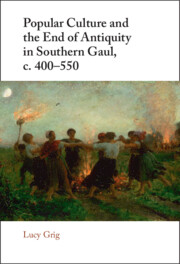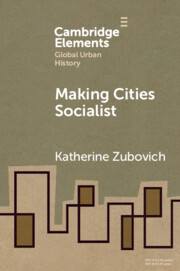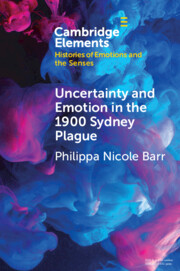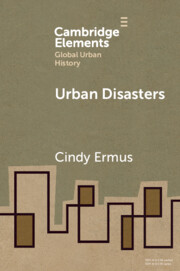137 results

Popular Culture and the End of Antiquity in Southern Gaul, c. 400–550
-
- Published online:
- 15 March 2024
- Print publication:
- 28 March 2024
2 - Deterritorialisation Discourse in International Law
-
- Book:
- The Rebirth of Territory
- Published online:
- 07 March 2024
- Print publication:
- 14 March 2024, pp 30-70
-
- Chapter
- Export citation

Making Cities Socialist
-
- Published online:
- 02 March 2024
- Print publication:
- 04 April 2024
-
- Element
- Export citation

Uncertainty and Emotion in the 1900 Sydney Plague
-
- Published online:
- 16 February 2024
- Print publication:
- 11 April 2024
-
- Element
- Export citation
Measuring It, Managing It, Fixing It? Data and Rights in Transnational and Local Climate Change Governance
-
- Journal:
- Transnational Environmental Law / Volume 13 / Issue 1 / March 2024
- Published online by Cambridge University Press:
- 06 February 2024, pp. 111-133
-
- Article
-
- You have access
- Open access
- HTML
- Export citation
16 - The 2030 Agenda, Climate Urbanism and Urban Planning in Zimbabwe
- from Part III - Sustainable Urban Planning in Africa
-
-
- Book:
- Reimagining Urban Planning in Africa
- Published online:
- 07 December 2023
- Print publication:
- 21 December 2023, pp 282-302
-
- Chapter
- Export citation
The Bureaucratic Politics of Urban Land Rights: (Non)Programmatic Distribution in São Paulo’s Land Regularization Policy
-
- Journal:
- Latin American Politics and Society , FirstView
- Published online by Cambridge University Press:
- 04 December 2023, pp. 1-27
-
- Article
-
- You have access
- Open access
- HTML
- Export citation
19 - The Early Modern City in Japan
- from Part III - Social Practices and Cultures of Early Modern Japan
-
-
- Book:
- The New Cambridge History of Japan
- Published online:
- 15 January 2024
- Print publication:
- 23 November 2023, pp 629-658
-
- Chapter
- Export citation
8 - Cities and Citizenship in Revolution
- from Part II - The British Colonies
-
-
- Book:
- The Cambridge History of the Age of Atlantic Revolutions
- Published online:
- 20 October 2023
- Print publication:
- 09 November 2023, pp 228-247
-
- Chapter
- Export citation
City-Level Law and Action for Climate-Resilient Development in Southern Africa
-
- Journal:
- Transnational Environmental Law / Volume 12 / Issue 3 / November 2023
- Published online by Cambridge University Press:
- 13 September 2023, pp. 567-593
-
- Article
-
- You have access
- Open access
- HTML
- Export citation
Different strategies in Indus agriculture: the goals and outcomes of farming choices
-
- Article
-
- You have access
- Open access
- HTML
- Export citation
Political trust and informal traders in African cities
-
- Journal:
- The Journal of Modern African Studies / Volume 61 / Issue 3 / September 2023
- Published online by Cambridge University Press:
- 20 October 2023, pp. 389-412
- Print publication:
- September 2023
-
- Article
- Export citation
The importance of a transformative biodiversity education for perceiving, appreciating and supporting lichen diversity in German urban environments
-
- Journal:
- The Lichenologist / Volume 55 / Issue 5 / September 2023
- Published online by Cambridge University Press:
- 22 September 2023, pp. 161-168
- Print publication:
- September 2023
-
- Article
-
- You have access
- HTML
- Export citation
7 - Exogenous Increase of Human Capital
-
- Book:
- Shocking Contrasts
- Published online:
- 09 June 2023
- Print publication:
- 17 August 2023, pp 156-186
-
- Chapter
- Export citation

Urban Disasters
-
- Published online:
- 26 July 2023
- Print publication:
- 31 August 2023
-
- Element
- Export citation
8 - Urban Sublimes
- from Part II - Romantic Sublimes
-
-
- Book:
- The Cambridge Companion to the Romantic Sublime
- Published online:
- 06 July 2023
- Print publication:
- 20 July 2023, pp 104-116
-
- Chapter
- Export citation
6 - Migration
-
-
- Book:
- The Whole Economy
- Published online:
- 09 June 2023
- Print publication:
- 15 June 2023, pp 164-199
-
- Chapter
- Export citation
23 - Immigrant Cities since the Late Nineteenth Century
- from Part VII - Migrant Communities, Cultures, and Networks
-
-
- Book:
- The Cambridge History of Global Migrations
- Published online:
- 12 May 2023
- Print publication:
- 01 June 2023, pp 481-498
-
- Chapter
- Export citation
14 - Climate Governance and Federalism in Switzerland
-
-
- Book:
- Climate Governance and Federalism
- Published online:
- 11 May 2023
- Print publication:
- 25 May 2023, pp 285-305
-
- Chapter
-
- You have access
- Open access
- HTML
- Export citation
Completing the Picture of the Depression Housing Crisis
-
- Journal:
- Enterprise & Society , First View
- Published online by Cambridge University Press:
- 15 May 2023, pp. 1-24
-
- Article
-
- You have access
- Open access
- HTML
- Export citation



